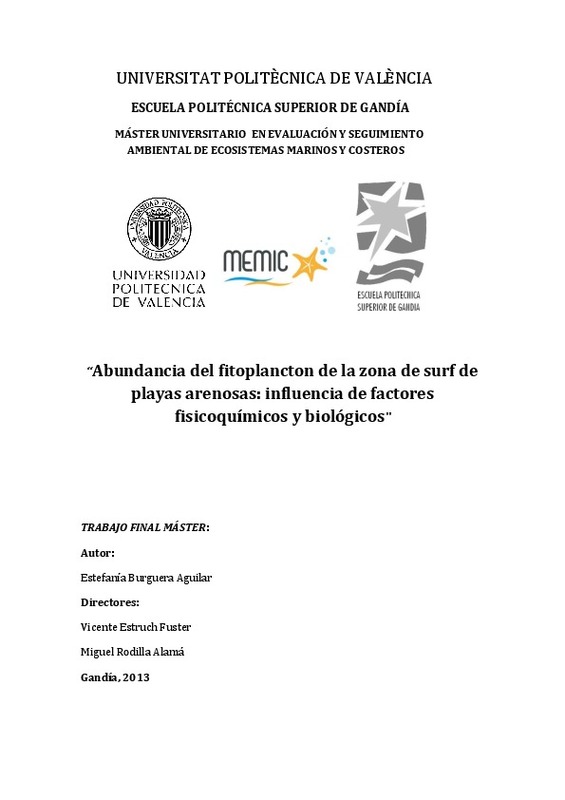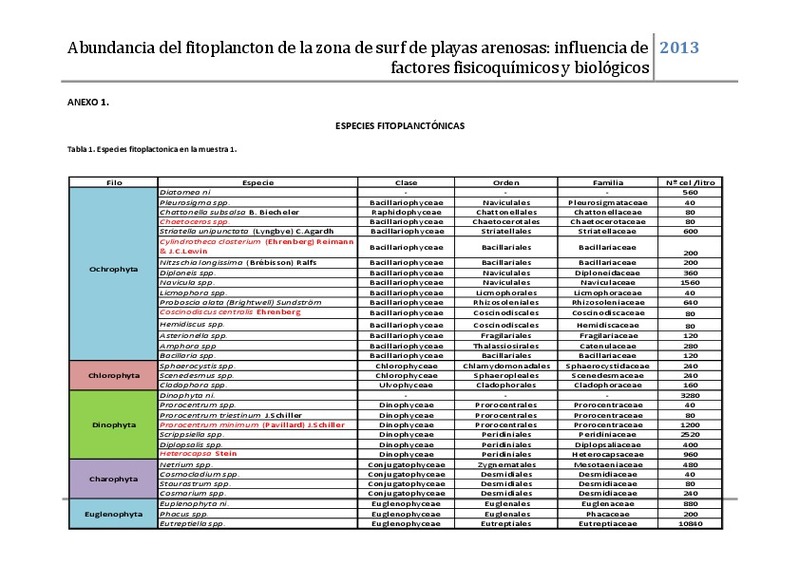JavaScript is disabled for your browser. Some features of this site may not work without it.
Buscar en RiuNet
Listar
Mi cuenta
Estadísticas
Ayuda RiuNet
Admin. UPV
Abundancia del fitoplancton de la zona de surf de playas arenosas: influencia de factores fisicoquímicos y biológicos
Mostrar el registro sencillo del ítem
Ficheros en el ítem
| dc.contributor.advisor | Rodilla Alamá, Miguel
|
es_ES |
| dc.contributor.advisor | Estruch Fuster, Vicente Domingo
|
es_ES |
| dc.contributor.author | Burguera Aguilar, Estefanía
|
es_ES |
| dc.date.accessioned | 2014-01-27T13:32:31Z | |
| dc.date.available | 2014-01-27T13:32:31Z | |
| dc.date.created | 2013-09-02 | |
| dc.date.issued | 2014-01-27 | |
| dc.identifier.uri | http://hdl.handle.net/10251/35179 | |
| dc.description.abstract | Las diferentes características físico, químicas y biológicas de las playas arenosas condicionarán la abundancia de fitoplancton en las zonas de surf además de la abundancia de la macrofauna bentónica y del zooplancton. Es objeto de estudio de este trabajo estudiar la relación entre el fitoplancton, zooplancton y macrofauna bentónica observando que factores son los que contribuyen a la aparición y cuáles influyen negativamente en el crecimiento de las diferentes especies. De esta manera se podrá tener una idea más interna del comportamiento de los ecosistemas marinos. Tras realizar el estudio se pueden destacar las siguientes relaciones entre el fitoplancton y los nutrientes: Ochorophyta y Euglenophyta dependen del fósforo soluble en reactivos (PSR); las Haptophyta dependen de los nitritos y sílice; Chlorophyta dependen del amonio mientras que las Charophyta dependen de PSR, nitritos y sílice. Respecto al zooplancton se encuentran las siguientes relaciones: Tintinidos - Ochorophyta, Euglenophyta y Dinophyta; Larvas de crustáceos - Haptophyta y Bigyra; Hidromedusas-Ochorophyta, Euglenophyta y Bigyra; y Cladóceros - Chlorophyta, Charophyta y Bigyra. Por último respecto a la relación encontrada entre la macrofauna y el zooplancton se observa que los moluscos dependen de los pterópodos, poliquetos y cladóceros, mientras que los crustáceos sólo dependen de los pterópodos. | es_ES |
| dc.description.abstract | The different physical, chemical and biological characteristics of the sandy beaches condition the abundance of phytoplankton in surf zones, moreover influence the abundance of benthic macrofauna and zooplankton. This study pretends to investigate the relationship between phytoplankton, zooplankton and benthic macrofauna taking into account what factors are those that contribute to their onset and which adversely affect the growth of different species. This helps to have a more internal known about the behavior of marine ecosystems. Concluded the study it is possible to highlight the following relationships between phytoplankton and nutrients: Ochorophyta and Euglenophyta depend on soluble reactive phosphorus (PSR), the Haptophyta depend on nitrites and silica; Chlorophyta depend on the ammonium while Charophyta depend on PSR, nitrite and silica. Regarding zooplankton the relationships are the following: tintinnids - Ochorophyta, Euglenophyta and Dinophyta; crustacean larvae - Haptophyta and Bigyra; hidromedusae - Ochorophyta, Euglenophyta and Bigyra; and cladocerans - Chlorophyta, Charophyta and Bigyra. Finally, the relationship found between macrofauna and zooplankton is that molluscs depend on pteropods, polychaetes and cladocerans while crustaceans depend on pteropods | es_ES |
| dc.format.extent | 56 | es_ES |
| dc.language | Español | es_ES |
| dc.publisher | Universitat Politècnica de València | es_ES |
| dc.rights | Reserva de todos los derechos | es_ES |
| dc.subject | Macrofauna | es_ES |
| dc.subject | Fitoplancton | es_ES |
| dc.subject | Zooplancton | es_ES |
| dc.subject | Parámetros físico-químicos-biológicos | es_ES |
| dc.subject | Phytoplankton | es_ES |
| dc.subject | Zooplankton | es_ES |
| dc.subject | Physical-chemical and biological parameters | es_ES |
| dc.subject | Ecosistema marino | es_ES |
| dc.subject.classification | MATEMATICA APLICADA | es_ES |
| dc.subject.classification | TECNOLOGIA DEL MEDIO AMBIENTE | es_ES |
| dc.subject.other | Máster Universitario en Evaluación y Seguimiento Ambiental de Ecosistemas Marinos y Costeros-Màster Universitari en Avaluació i Seguiment Ambiental d'Ecosistemes Marins i Costaners | es_ES |
| dc.title | Abundancia del fitoplancton de la zona de surf de playas arenosas: influencia de factores fisicoquímicos y biológicos | es_ES |
| dc.type | Tesis de máster | es_ES |
| dc.rights.accessRights | Abierto | es_ES |
| dc.contributor.affiliation | Universitat Politècnica de València. Instituto de Investigación para la Gestión Integrada de Zonas Costeras - Institut d'Investigació per a la Gestió Integrada de Zones Costaneres | es_ES |
| dc.contributor.affiliation | Universitat Politècnica de València. Departamento de Ingeniería Hidráulica y Medio Ambiente - Departament d'Enginyeria Hidràulica i Medi Ambient | es_ES |
| dc.contributor.affiliation | Universitat Politècnica de València. Escuela Politécnica Superior de Gandia - Escola Politècnica Superior de Gandia | es_ES |
| dc.description.bibliographicCitation | Burguera Aguilar, E. (2013). Abundancia del fitoplancton de la zona de surf de playas arenosas: influencia de factores fisicoquímicos y biológicos. Universitat Politècnica de València. http://hdl.handle.net/10251/35179 | es_ES |
| dc.description.accrualMethod | Archivo delegado | es_ES |
Este ítem aparece en la(s) siguiente(s) colección(ones)
-
EPSG - Trabajos académicos [5004]
Escuela Politécnica Superior de Gandia







